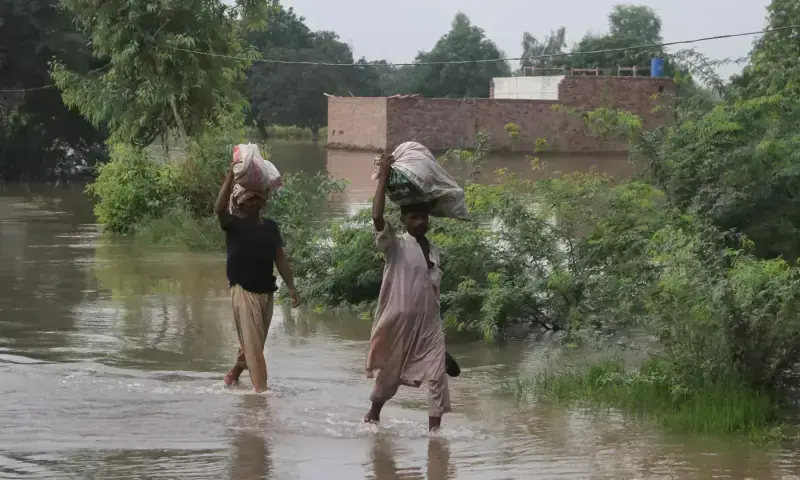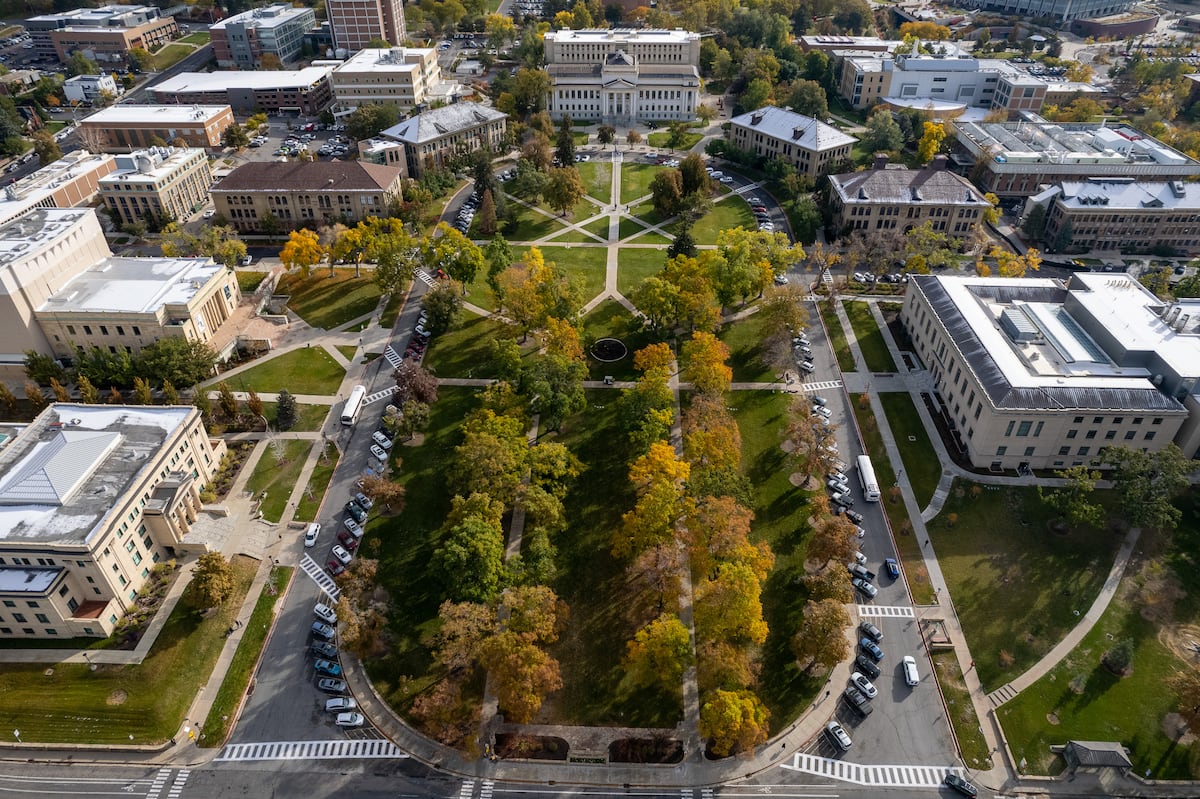By Amin Ahmed | Jamal Shahid
Copyright dawn

PM doubles compensation for families of victims to Rs2m
• 161,000 houses, 395 health facilities damaged in Punjab, UNOCHA says
• Senate panel told deluges left 1,000 dead, millions displaced
ISLAMABAD: As millions of people have been affected and hundreds of casualties reported across the country during the recent floods and monsoon rains, the prime minister has raised the ex-gratia assistance for the next of kin of those who lost their lives from Rs1 million to Rs2m.
More than 4.2 million people in 18 districts of Punjab have been affected by the recent floods, with Muzaffargarh alone accounting for over a quarter of the total, according to a Rapid Needs Assessment (RNA) report released by the United Nations Office for the Coordination of Humanitarian Affairs (UNOCHA).
Muzaffargarh, located on the bank of the Chenab River, is followed by Jhang with 646,000 affected people (15.3 per cent), Bahawalpur with 514,000 (12.2pc), Khanewal with 397,000 (9.4pc), and Multan with 347,000 (8.2pc). Other affected districts include Vehari, Bahawalnagar, Hafizabad, Okara, Chiniot, Gujrat, Rahim Yar Khan, Kasur, Sialkot, Mandi Bahauddin, Narowal, Dera Ghazi Khan and Gujranwala.
The RNA, conducted from Sept 8 to 18 in collaboration with the government, covered 1,928 mouzas in these 18 flood-hit districts.
Out of 161,000 houses assessed, about 115,700 were partially damaged and 46,000 fully or severely damaged, leaving thousands of families without adequate shelter. More than 93pc of the assessed locations reported some level of housing damage, with the highest numbers in Muzaffargarh, Rahim Yar Khan, Khanewal and Jhang. Approximately 2.8m people have been displaced, many forced to leave flooded, damaged or destroyed homes.
According to the report, the affected population faces urgent shelter and non-food item (NFI) needs, particularly tents, tarpaulins, GI sheets, plastic sheeting and winterisation kits, including blankets, bedding, mats, shawls, mosquito nets and warm clothes.
Health facilities
A total of 742 health facilities were assessed across the 18 districts; 395 were reported damaged — 315 partially and 80 fully or severely — posing a serious threat to the continuity of healthcare services. The highest proportions of damage were observed in Gujranwala, Bahawalnagar and Okara.
In absolute terms, Bahawalnagar recorded the greatest impact with 64 facilities damaged, followed by Jhang (55) and Muzaffargarh (46). Other districts also reported significant damage, including Bahawalpur (35), Chiniot (39) and Khanewal (25), with several facilities fully destroyed.
By contrast, Mandi Bahauddin (8pc), Vehari (17pc) and Dera Ghazi Khan (22pc) reported relatively limited impact. The scale of damage in the hardest-hit districts underscores the urgent need to restore and reinforce health infrastructure, as disruptions could reduce access to essential care, delay outbreak response and heighten community vulnerability.
The RNA highlights a significant disease burden across 1,928 flood-affected villages. Malaria was the most reported health concern (64pc of assessed villages), followed by skin infections and diarrhoea, indicating deteriorating water, sanitation, and hygiene conditions. Dengue was also reported at considerable levels, adding to the challenge of vector-borne diseases.
Educational institutions
According to the School Education Department, floods damaged 667 schools across the 18 districts, of which 54pc were girls’ schools.
Moreover, 217 schools were repurposed as evacuation centres, affecting 101,263 enrolled students. Most damage was recorded in Sialkot (210 schools), followed by Jhang (110), Gujrat (83), Muzaffargarh and Kot Addu (82 each), and Rahim Yar Khan (15).
Nearly 97,000 water supply schemes were reported damaged. Over one-third of the assessed villages reported damage to these schemes. Of the 48,500 fully damaged schemes, 60pc were in Muzaffargarh, 12pc in Jhang, and 10pc in Bahawalpur.
Before the floods, communities in most districts relied heavily on agriculture and livestock for their livelihoods. Crop farming was the primary source of income for over 85pc of communities in Gujranwala, Hafizabad, Kasur, Khanewal, and Vehari, with similarly high levels in Bahawalnagar, Bahawalpur, Chiniot, Multan, and Narowal.
Livestock rearing engaged more than 70pc of communities in most areas, while daily wage labour was a key income source in Bahawalnagar, Gujranwala, and Khanewal. Floods have devastated these livelihoods by damaging crops, killing livestock, and disrupting agricultural cycles, leaving many households without produce or animals to sell. As farming activities stall, wage opportunities linked to farm work and local markets are shrinking, pushing vulnerable communities deeper into income loss and food insecurity.
Most communities reported having food stocks lasting only a week or less. Food insecurity is most critical in Multan, where 81.7pc of communities reported very limited stocks. Similarly, 76.2pc in Bahawalnagar, 74pc in Muzaffargarh, and 61.5pc in Bahawalpur said their food would run out within days.
Ex-gratia assistance
Meanwhiel, the Senate standing committee on cabinet secretariat was informed that the premier raised the ex-gratia assistance for the next of kin of those who lost their lives during the floods from Rs1m to Rs2m. The revised compensation package will have a financial impact of about Rs2.033 billion.
The committee’s meeting, chaired by Senator Rana Mehmoodul Hassan, was briefed on the overall flood situation by a member of the National Disaster Management Authority (NDMA).
He reported that around 1,000 people had died in the recent floods, while about 1,000 others had sustained various injuries. He added that the numbers were expected to rise once rescue, evacuation, and relief operations were completed and floodwaters receded.
The NDMA said around three million people had been rescued or evacuated between June 26 and Sept 19. The committee was also told the floods damaged 12,559 houses and resulted in the loss of 6,509 livestock. The figures are expected to rise as assessments continued.
The meeting was attended by senators Saadia Abbasi, Ataur Rehman, Aimal Wali Khan, Mohammad Abdul Qadir, Dr Afnanullah Khan, and Shahadat Awan, along with the secretary of the Establishment Division, special secretary of the Cabinet Division, chairman of the Pakistan Telecommunication Authority, and other senior officials.
Published in Dawn, September 27th, 2025



